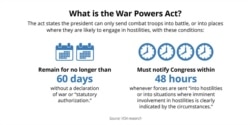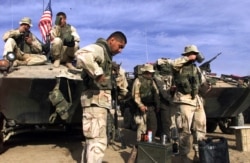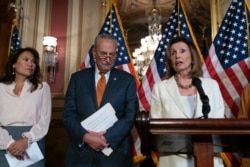The U.S. House of Representatives will vote this week on legislation aimed at preventing the engagement of U.S. forces with Iran unless Congress gives its approval.
The vote comes after U.S. President Donald Trump ordered an airstrike last week that killed Iranian General Qassem Soleimani, escalating regional tensions and leading many congressional Democrats to express concerns the move could lead to open war between the U.S. and Iran.
How does the U.S. declare war?
According to Article I of the U.S. Constitution, Congress has the authority to declare war, while Article II gives the president the responsibility of being the commander-in-chief of the armed forces. The framers of the Constitution deliberately split these powers among branches of the U.S. government to prevent an unconsidered, unilateral move toward war.
Throughout American history, the legislative and executive branches have clashed over the interpretation of these powers as laid out in the Constitution. These questions increased as American conflicts abroad – including U.S. involvements in Korea and Vietnam – became increasingly difficult to define and occurred without an official declaration of war. The last time Congress passed an official declaration of war was almost 80 years ago, during World War II.
What does the 1973 War Powers Act say about the ability to declare war?
In 1973, Congress passed legislation further defining the president’s role in directing military actions abroad following the revelation that then-President Richard Nixon had conducted secret bombings of Cambodia. The law mandated that U.S. presidents had 48 hours to report to Congress after committing U.S. forces abroad as well as detailing the justifications for those actions.
According to the law, these safeguards insure that “the collective judgment of both the Congress and the president will apply” to the deployment of U.S. troops overseas. It also requires presidents to end overseas involvements after 60 days if Congress has not passed an official declaration of war.
Presidents of both parties have challenged or redefined interpretations of this law since it was called “unconstitutional and dangerous” by President Nixon.
What is the 2001 Authorization for Use of Military Force, or AUMF, and how does it relate to the debate now?
In the wake of the Sept. 11, 2001, terrorist attacks, President George W. Bush described those strikes against the United States as “acts of war.” Bush worked with Congress on the resolution broadly authorizing actions to combat the terrorist threat internationally.
The AUMF has sparked continued debate as Presidents Bush, Obama and Trump have used the legislation’s broad definitions of a terrorist threat to justify military actions internationally. Unlike other authorizations for conflict that allow for hostilities against specific nations or unnamed nations in specific areas, the AUMF allows for actions against organizations or persons.
Attempts in Congress to pass a new AUMF - addressing the changing nature of terrorist threats as well as more specifically defining individuals and entities that pose a threat - have failed. Lawmakers did pass a second AUMF in 2002, specifically authorizing the United States to invade Iraq.
How does President Trump interpret these laws?
Although the Trump administration has not cited the 2001 AUMF as justification for the airstrike on Soleimani, Vice President Mike Pence misleadingly tweeted a claim that the general had supported the travel of some of the 9/11 hijackers. The vice president’s office later clarified that he had been referring to Iran allowing some of the hijackers to pass through the country on the way to Afghanistan.
Analysts say the president appears to be using his ability to strike under the War Powers Act.
“Authorized use of military force is currently linked to our counterterrorism authorities against ISIS and affiliates in the region. So it is a stretch to extend them to the Iran threat network and people like Qassem Soleimani," Kirsten Fontenrose, director of the Scowcroft Middle East Security Initiative at the Atlantic Council, told VOA.
"The administration undertook an effort to designate Qassem Soleimani as a foreign terrorist, and in doing so, that extends counterterrorism authorities to his person. So, the administration did have the authority to strike Qassem Soleimani.”
“The authorities were in place because they don't have to rely on that AUMF-authorized use of military force counterterrorism authority; they can instead rely on the War Powers Act that gives the president this express authority in the immediate aftermath of a strike,” she said.
The Trump administration notified Congress of the airstrike that killed Soleimani Saturday, citing intelligence of imminent planned attacks on U.S. personnel as justification. House Speaker Nancy Pelosi said the classified notification “raises more questions than it answers.”
In a tweet Sunday, Trump appeared to address the War Powers Act notification requirements, saying, “These Media Posts will serve as notification to the United States Congress that should Iran strike any U.S. person or target, the United States will quickly & fully strike back, & perhaps in a disproportionate manner. Such legal notice is not required, but is given nevertheless!”
Congressional leaders have not directly addressed the president claiming social media as an adequate form of notification. It is doubtful a tweet would be considered formal notification under the requirements of the War Powers Act.
How is Congress responding?
Congressional Democrats have expressed a number of concerns about the killing of Soleimani, starting with the administration’s communications with the legislative branch regarding the airstrike.
“We are concerned that the administration took this action without the consultation of Congress and without respect for Congress’s war powers granted to it by the Constitution,” House Speaker Nancy Pelosi said in a letter informing members of the upcoming vote Sunday. She said the resolution “reasserts Congress’s long-established oversight responsibilities by mandating that if no further congressional action is taken, the administration’s military hostilities with regard to Iran cease within 30 days.”
On Friday, Senate Minority Leader Chuck Schumer noted the killing of Soleimani was consequential enough to lead to open conflict with Iran.
“It is my view that the president does not have the authority for a war with Iran,” Schumer said on the Senate floor. “If he plans a large increase in troops and potential hostility over a longer time, the administration will require congressional approval, and the approval of the American people. The president's decision may add to an already dangerous and difficult situation in the Middle East. The risk of a much longer military engagement in the Middle East is acute and immediate. This action may well have brought our nation closer to another endless war, exactly the kind of endless war the president promised he would not drag us into.”
Democratic Senator Tim Kaine has introduced a war powers resolution that will force a vote in the Senate on the issue. The text of that legislation notes the Trump administration has acknowledged neither the 2001 or 2002 AUMFs provides specific statutory authorization for military action against Iran.
“The question of whether United States forces should be engaged in armed conflict against Iran should only be made following a full briefing to Congress and the American public of the issues at stake, a public debate in Congress, and a congressional vote as contemplated by the Constitution,” the legislation stipulates.
The companion legislation that will receive a vote in the U.S. House this week has not yet been released but will be along similar lines, according to Speaker Pelosi.












